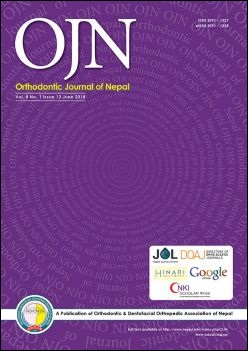Treatment of Class II Div 2 Malocclusion using PowerScope: A Case Report
DOI:
https://doi.org/10.3126/ojn.v8i1.21352Keywords:
Class II Div 2 malocclusion, fixed functional appliance, mandibular deficiency, non-extraction, PowerScopeAbstract
Correction of skeletal Class II malocclusion has become a major challenge for orthodontists. Class II jaw discrepancies characterized by mandibular deficiency are treated with fixed functional appliances when there is no active growth present. This case report illustrates the application of PowerScope in 16 years young adolescent male having skeletal Class II Div 2 with mandibular deficiency who was reported with forwardly and irregularly placed upper front teeth with closed bite. The case was treated initially with MBT 0.022” prescription followed by PowerScope. Successful results were obtained with a substantial improvement in facial profile, skeletal jaw relationship and overall aesthetic appearance. PowerScope produced a significant forward movement of mandible which obliterated the need of extractionsDownloads
Download data is not yet available.
Abstract
838
PDF
1594
Downloads
Published
2018-10-13
How to Cite
Agarwal, L., Singh, K., & Tandon, R. (2018). Treatment of Class II Div 2 Malocclusion using PowerScope: A Case Report. Orthodontic Journal of Nepal, 8(1), 63–67. https://doi.org/10.3126/ojn.v8i1.21352
Issue
Section
Case Reports
License
Copyright © held by Orthodontic & Dentofacial Orthopedic Association of Nepal
- Copyright on any research article is transferred in full to the Orthodontic & Dentofacial Orthopedic Association of Nepal upon publication in the journal. The copyright transfer includes the right to reproduce and distribute the article in any form of reproduction (printing, electronic media or any other form).
- Articles in the Orthodontic Journal of Nepal are Open Access articles published under the Creative Commons CC BY License (https://creativecommons.org/licenses/by/4.0/)
- This license permits use, distribution and reproduction in any medium, provided the original work is properly cited.




